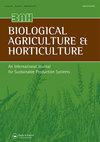Effect of plant extracts and emulsifiers on control of anthracnose (Colletotrichum coccodes) in persimmon trees
IF 1.6
4区 农林科学
Q3 AGRONOMY
引用次数: 2
Abstract
ABSTRACT This study was conducted to determine suppression of the anthracnose fungus (Colletotrichum coccodes), causing disease in persimmon trees (Diospyros kaki Thunb), by (1) extracts from various parts of 45 plant species from 27 families obtained using different extraction methods, and (2) selected plant extracts and emulsifiers. Fermentation extracts of Torilis japonica roots and Portulaca oleracea, all above ground parts, as well as ethanol extracts of Rheum palmatum roots and Cinnamomum cassia barks were found to effectively suppress anthracnose, leading to 83%, or more, suppression by 10% plant extracts in laboratory tests. Additionally, anthracnose was suppressed by 100% by 3% brown rice vinegar, 3% powder soap, 5% loess sulphur, and by 5% natural emulsifier-B in a laboratory test. In the field trial with organically grown persimmon trees, treatments with plant extracts used on their own, resulted a reduction of anthracnose by 63% and 51% by 5% fermentation extract of T. japonica and 5% ethanol extract of R. palmatum, respectively, compared with a control. However, in treatments with combinations of plant extracts and emulsifiers, anthracnose was reduced by 79%, 67%, 63% and 56% when treated with 5% fermentation extract of T. japonica + natural emulsifier-B (1%), 5% fermentation extract of T. japonica + loess sulphur (1%), 5% ethanol extract of R. palmatum + natural emulsifier-B (1%), and 5% ethanol extract of R. palmatum + loess sulphur (1%), respectively, compared with the control. Thus, mixtures of plant extracts and emulsifiers may be used to control anthracnose in organic production systems.植物提取物和乳化剂防治柿子炭疽病的效果
摘要本研究通过(1)采用不同提取方法从27科45种植物的不同部位提取提取物,(2)筛选植物提取物和乳化剂,测定了对引起柿子树炭疽病的炭疽菌(Colletotrichum coccades)的抑制作用。在实验室测试中,发现所有地上部分的托利斯(Torilis japonica)根和马齿苋(Portulaca oleracea)的发酵提取物,以及掌叶大黄(Rheum palmatum)根和肉桂皮的乙醇提取物都能有效抑制炭疽病,10%的植物提取物对炭疽病的抑制率达到83%或更多。此外,在实验室试验中,3%糙米醋、3%粉末肥皂、5%黄土硫和5%天然乳化剂B对炭疽病的抑制率为100%。在有机种植的柿子树的田间试验中,与对照相比,单独使用植物提取物处理,通过5%的T.japonica发酵提取物和5%的R.palmatum乙醇提取物,炭疽病分别减少了63%和51%。然而,在植物提取物和乳化剂的组合处理中,当用5%的T.japonica发酵提取物+天然乳化剂B(1%)、5%的T.japonica发酵提取液+黄土硫(1%),5%的R.palmatum乙醇提取物+天然乳油B(1%,与对照组相比。因此,植物提取物和乳化剂的混合物可用于控制有机生产系统中的炭疽病。
本文章由计算机程序翻译,如有差异,请以英文原文为准。
求助全文
约1分钟内获得全文
求助全文
来源期刊
CiteScore
3.30
自引率
6.70%
发文量
18
审稿时长
>36 weeks
期刊介绍:
Biological Agriculture & Horticulture aims to act as the central focus for a wide range of studies into alternative systems of husbandry, and particularly the biological or organic approach to food production. The Journal publishes work of a sound scientific or economic nature related to any aspect of biological husbandry in agriculture, horticulture and forestry in both temperate and tropical conditions, including energy and water utilization, and environmental impact.

 求助内容:
求助内容: 应助结果提醒方式:
应助结果提醒方式:


